Occupational environment monitoring at the factory producing frozen meat
99,000 ₫
Note: The above price is calculated for one sample, the price may fluctuate depending on the area of the environment to be monitored and the movement of the market. For more accurate price support, please refer to the quotation table or contact directly with our consulting staff.
Environmental monitoring of frozen meat processing factories is a session of collecting, analyzing, and evaluating factors in the workplace that may be harmful to the health of workers.
Table of Contents
Toggle1. Overview of frozen meat factory
a. What is a frozen meat factory?
Factory producing frozen meat is an industrial facility specializing in processing and packaging fresh meat or processed meat into frozen meat products. The frozen meat production process usually includes steps such as preparation, processing, packaging, and freezing meat to maintain quality and extend shelf life.
This factory is usually equipped with advanced technology devices and refrigeration systems to ensure that the freezing process is carried out safely and efficiently. Frozen meat after production is often packed in specialized packaging or boxes that meet hygiene and preservation standards. Then, it can be transported to stores, restaurants, or other retail outlets for further consumption or continue storage in cold warehouses.
The freezing process helps preserve quality, retain the flavor and nutritional value of meat for a long time. It also helps prevent the growth of bacteria and negative effects of microorganisms on food.

b. Production stages in frozen meat factory
The production stages in frozen meat factory may include the following steps:
- Receiving fresh meat: Fresh meat is transported to the factory from suppliers such as livestock farms, seafood processing factories, or other meat suppliers.
- Quality inspection: Meat is checked to ensure it meets standards of shape, color, smell, freshness, and shows no signs of any disease or spoilage.
- Meat processing: Meat is processed to remove unwanted parts such as fat, skin, bones, and other inedible parts. Then, if necessary, meat may be cut into smaller pieces or processed into specific frozen meat products.
- Packing: Meat is packed in specialized packaging, such as nylon bags or waterproof boxes. Packing is carried out to prevent exposure to air and other external factors, thereby protecting meat from oxidation and quality loss.
- Freezing: The packed meat is then placed into freezing systems, where the temperature is lowered to very low levels, usually below 0 degrees Celsius. The freezing process helps preserve meat and extend shelf life.
- Storage and transportation: After freezing, meat can be stored in cold storage at the factory or transported to stores, restaurants, or other retail outlets for consumption.

c. Types of machinery used in frozen meat factory
In frozen meat factory, many types of machinery and equipment are used to carry out production stages. Below are some common machines often used in the frozen meat production process:
- Meat processing machines: Including equipment such as meat cutting machines, meat grinders, meat mincers, bone separators, sausage makers, and meat forming machines. These machines help carry out preparation and processing stages before packing and freezing.
- Packing machines: Including vacuum packing machines, waterproof packing machines, bag packing machines, box packing machines, and other related equipment. These machines are used to pack meat into specialized packaging, ensuring safety and convenience in transportation and use.
- Freezing systems: Including freezers, cold storage, and refrigeration systems. These devices create the necessary low temperatures to freeze meat and maintain cold conditions during storage.
- Quick freezing machines: Quick freezing machines are used to rapidly freeze certain types of meat or specific meat products, such as ground meat or chicken.
- Air treatment machines: These include air filters, air conditioners, and ventilation systems. They help maintain appropriate environmental conditions in the factory, ensuring ventilation, reducing odors, and creating a safe and healthy working environment for employees.

d. What occupational diseases can workers in frozen meat factory suffer from?
Workers in frozen meat factory may suffer from some occupational diseases related to the working environment and production process. Below are some examples of common occupational diseases that may occur:
- Pneumonia related to dust: Jobs such as grinding meat, mincing meat, or working in meat dust environments may cause pneumonia due to exposure to dust and meat vapor. Examples include byssinosis or pneumonia from meat vapor.
- Allergies and dermatitis: Contact with allergens such as meat proteins, chemicals during production, and working with animal skin may cause allergy problems and dermatitis, such as contact dermatitis and allergic dermatitis.
- Spine and musculoskeletal diseases: Working in an industrial environment may cause physical stress on the spine and musculoskeletal system, due to heavy loads, incorrect working posture, and repetitive activities.
- Diseases from chemical exposure: During production, chemicals such as detergents, disinfectants, or preservatives are used. Long-term exposure to these substances may cause health issues such as dermatitis, pharyngitis, or respiratory problems.
- Hand and neck diseases: Jobs related to cutting, processing, and packing meat may cause injuries and problems in hands and neck, such as muscle injuries, neck pain, hand pain, and shoulder pain.
To ensure safety and protect workers’ health, protective measures such as ensuring the use of protective equipment, complying with labor safety procedures, controlling dust and chemicals, and ensuring correct work stages are very important in frozen meat factory.

e. Common types of frozen meat products on the market
On the market, there are many common types of frozen meat products produced and marketed. Below are some common types of frozen meat products:
- Fresh frozen meat: Fresh frozen meat is fresh meat frozen immediately after harvesting or after fresh processing. Fresh frozen meat includes beef, pork, poultry, and seafood.
- Processed frozen meat: These are meat products processed into specific products before freezing. Examples include frozen ground meat, frozen sausages, frozen fried chicken, and other processed foods from frozen meat.
- Frozen chicken: Frozen chicken products include processed and frozen chicken such as whole frozen chicken, chicken parts like wings, frozen drumsticks, and frozen chicken balls.
- Steamed frozen meat: This type of meat is steamed and then frozen, including steamed meat, stewed meat, and other products such as frozen steamed sticky rice with meat.
- Dishes made from frozen meat: In addition to the above types of frozen meat, there are many other dishes made from frozen meat such as meat sandwiches, meat pizza, meat noodles, and other dishes.
2. Overview of occupational environment monitoring service
a. What is occupational environment monitoring in frozen meat factory?
Occupational environment monitoring (or measurement of occupational environment) in frozen meat factory is the activity of collecting, evaluating, and analyzing measurement indicators of occupational environmental factors at frozen meat factory, in order to take timely measures to minimize environmental harm to workers’ health and prevent occupational diseases. Occupational environment monitoring is a mandatory regulation for frozen meat factories.
Occupational environment monitoring plays the most important role in caring for, protecting, and improving workers’ health because the main resource of the enterprise and the direct source of profit is the workers. Workers frequently exposed to hazardous factors beyond permissible standards will be affected in health and may develop occupational diseases.
REGISTER FOR OCCUPATIONAL ENVIRONMENT MONITORING SERVICE
b. Occupational environment monitoring program of Nam Viet
The occupational environment monitoring program of Nam Viet is a program researched by monitoring engineers in the field of occupational safety and environmental protection. With the goal of ensuring health and safety for workers, this program uses modern measurement methods to monitor air quality, water, microclimate factors, physics, dust… in the working environment. This is a very important program in ensuring a safe working environment and protecting workers’ health.
In addition, the occupational environment monitoring program of Nam Viet also plays an important role in researching and developing new solutions to improve occupational environment quality. With the dedication and professionalism of the monitoring expert team, the exclusive monitoring program of Nam Viet is becoming a breakthrough in the field of occupational safety management and environmental protection in Vietnam.

c. Standardization in occupational environment measurement process
Standardization in occupational environment measurement process of Nam Viet is a very important aspect in ensuring the quality of measurement results. To ensure accuracy and reliability of results, this program uses recognized standards and standardized procedures of the Department of Health Ho Chi Minh City. This ensures that collected data will be used with high reliability in evaluating the occupational environment and making decisions to improve the working environment to protect workers’ health.
These standardized processes also ensure that measurement results are carried out by monitoring specialists with high qualifications and many years of experience, helping managers and experts trust the results from An Toan Nam Viet and make accurate and valuable decisions in protecting workers’ health and the environment.
By applying standardization in the occupational environment measurement process, Nam Viet is demonstrating its commitment to ensuring a safe working environment and protecting workers’ health, while also positively contributing to the development and improvement of occupational safety management and environmental protection quality in Vietnam.
d. Monitoring reports in frozen meat factory
The occupational environment monitoring results are prepared according to form No. 04 Appendix III issued with Decree 44/2016/ND-CP and made into 02 copies: 01 copy sent to the labor facility that signed the contract for occupational environment monitoring and 01 copy kept at the organization performing occupational environment monitoring.
The storage period for occupational environment monitoring results according to the law is indefinite record storage.

e. Frequency of occupational environment monitoring according to law
According to Clause 2 Article 18 of the Law on Occupational Safety and Hygiene 84/2015/QH13, employers must organize occupational environment monitoring to evaluate harmful factors at least once a year.
f. Deadline for submitting occupational environment monitoring reports according to law
The deadline for submitting reports is before December 31 every year, enterprises belonging to production facilities are required to submit occupational environment monitoring reports to the Department of Health at the locality where the main headquarters and workers are located.
When there are changes in technology processes, production processes, or when renovating or upgrading labor facilities with potential new harmful factors to workers’ health, enterprises belonging to production facilities must update occupational hygiene records related to harmful factors requiring occupational environment monitoring.
g. Regulations on penalties for violations of occupational environment monitoring for employers
According to Article 27 of Decree No. 12/2022/ND-CP dated January 17, 2022 on administrative penalties in the field of labor, social insurance, and Vietnamese workers working abroad under contracts.
- Clause 2: A fine of 2,000,000 – 5,000,000 VND for employers who do not publicly announce to workers at occupational environment monitoring sites and at inspected, evaluated sites the results of occupational environment monitoring and results of inspection, evaluation, and management of hazardous factors at the workplace immediately after results are available.
- Clause 3: A fine of 20,000,000 – 40,000,000 VND for employers who fail to conduct occupational environment monitoring to control harmful effects on workers’ health as prescribed by law.
- Clause 4: A fine of 40,000,000 – 60,000,000 VND for employers who collude with organizations conducting occupational environment monitoring to commit fraud in occupational environment monitoring activities but not to the extent of criminal liability.
3. Harmful environmental factors for workers in frozen meat processing factories
Workers in frozen meat processing factories may be exposed to many harmful environmental factors. Below are some potential environmental factors that may harm workers in the frozen meat processing industry:
- Fumes, gases, and dust particles: The frozen meat production process can generate fumes, gases, and dust particles from meat, cleaning agents, preservatives, and other chemicals. Workers may inhale these substances during work, causing respiratory and eye problems such as pneumonia, rhinitis, shortness of breath, eye irritation, and discomfort.
- Humidity and temperature: The working environment in frozen meat factories often has high humidity and low temperatures to maintain meat freshness. Continuous exposure to this environment can cause skin problems such as dermatitis, cracked skin, and dry skin.
- Noise: Equipment and machinery in frozen meat factories can generate high noise levels. Prolonged exposure to noise can lead to hearing problems such as hearing loss and ear disorders.
- Musculoskeletal injuries: Working in an industrial environment carries risks of injury from falling heavy objects, impacts, cuts, or working in awkward positions. This may cause musculoskeletal injuries such as back, neck, shoulder, and hand injuries.
- Chemicals: Frozen meat production may involve cleaning agents, disinfectants, and preservatives. Workers may be directly or indirectly exposed to these substances, posing risks to skin, eyes, and respiratory health.
REGISTER FOR OCCUPATIONAL ENVIRONMENT MONITORING SERVICE
4. Measures to improve the working environment in frozen meat processing factories
To improve the working environment in frozen meat processing factories and protect workers’ health, the following measures can be applied:
- Dust and chemical management: Ensure control of dust and chemicals during frozen meat production. Use effective dust extraction systems, ensure good ventilation, and apply safe, eco-friendly chemicals.
- Ensure ventilation and exhaust fans: Ensure proper ventilation systems in factories, especially in areas with toxic gases, meat fumes, or meat dust. Use exhaust fans and air systems to remove harmful substances and improve air quality.
- Provide protective equipment: Ensure workers are fully equipped with personal protective equipment, including masks, safety glasses, gloves, raincoats, and other gear suitable for their tasks.
- Ensure safe working conditions: Ensure workers receive training on occupational safety, safe work procedures, and fire and explosion prevention. Establish workplace safety measures, restrict access to hazardous areas, and provide clear safety instructions and signage.
- Noise management: Apply measures to reduce noise at the source, such as using soundproof equipment, regularly maintaining machinery to minimize noise emissions, and providing hearing protection for employees.
- Training and education: Provide training on occupational safety, safe working techniques, and environmental management for workers. Create a workplace that raises safety awareness, encourages reporting of health and safety issues, and promotes personal responsibility in protecting the work environment.
- Regularly conduct occupational environment monitoring in factories, collect and analyze harmful factors affecting workers, and adjust to reduce risks, thereby preventing occupational diseases for them.
5. Benefits of regular monitoring in frozen meat processing factories
An Toan Nam Viet provides businesses with excellent benefits when using occupational environment monitoring services in compliance with Decree 44/2016/NĐ–CP on managing and controlling harmful workplace factors affecting workers.
- Businesses can proactively control harmful factors in workshops or factories.
- Receive consulting and recommendations on measures to minimize harmful factors and improve workplace quality.
- Indirectly protect human resources, the key factor in business development.
- Reduce the impact of occupational diseases on workers’ health, thereby lowering future treatment costs.
- Improve workers’ health, leading to better product quality and stable productivity.
- Comply with occupational safety regulations, avoiding legal risks.
- Build credibility and professionalism in all aspects, enhancing the company’s brand reputation.
The environmental monitoring service of Nam Viet is the solution to minimize the impact of occupational diseases, contributing to a healthy and high-quality working environment.

6. National Occupational Environment Monitoring Center
Occupational environment monitoring center of Nam Viet is a professional unit in monitoring and measuring occupational environment quality nationwide across all provinces in Vietnam. With a team of experienced monitoring specialists, the center uses modern measuring equipment to ensure accuracy and reliability.
In addition to providing monitoring services, the center also supports clients in planning, handling, and tracking occupational environment issues. With the motto “customers at the center,” the center focuses on customer satisfaction, meeting all client needs, and committing to the best solutions for businesses.
REGISTER FOR OCCUPATIONAL ENVIRONMENT MONITORING SERVICE
With investments in technology, equipment, and human resources, the monitoring center of Nam Viet has become one of the reputable units in occupational environment monitoring in Ho Chi Minh City with the following goals:
- We always value brand reputation and the quality of our services.
- We provide clients with the best and most suitable solutions possible.
- With a team of experienced Masters and Engineers, we aim to protect the environment and bring value to businesses.
- With An Toan Nam Viet Monitoring team, your company will receive professional services from experts in the monitoring field, along with the best cost advantages.
The occupational environment monitoring process at Nam Viet includes the following basic steps:
- Before performing occupational environment monitoring, our company always ensures monitoring machinery and equipment are calibrated and standardized according to legal requirements.
- Strictly follow the occupational environment monitoring procedures committed to the Department of Health.
- Accurately report monitoring results to employers.
- If monitoring results show unsafe conditions for workers, Nam Viet will support by providing corrective solutions, and the workplace will implement the following:
- Implement measures to improve working conditions, minimizing harmful factors and preventing occupational diseases.
- Organize medical check-ups to detect occupational diseases and work-related illnesses early for workers in unsafe environments.
- Provide physical allowances to workers as required by labor laws.

7. Occupational Environment Monitoring Price Quotation
To help businesses carry out occupational environment monitoring professionally and effectively, Nam Viet provides clients with a high-quality, reasonably priced occupational environment monitoring service price list.
- Our monitoring quotation provides detailed information about the costs of the monitoring services we offer, including transportation, measurement, analysis, and reporting fees. Clients can be assured of the accuracy and reliability of the monitoring reports we provide.
- We are committed to offering the most competitive and reasonable prices on the market, and we are always ready to provide quick and professional consulting to address all inquiries regarding monitoring services.
- With Nam Viet’s monitoring quotation, clients can easily choose service packages that suit their needs. We are committed to delivering the highest satisfaction with professional service quality.
No comments yet

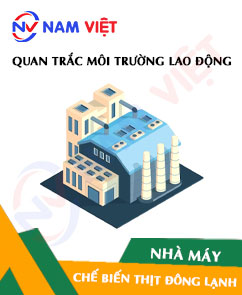
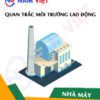
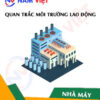






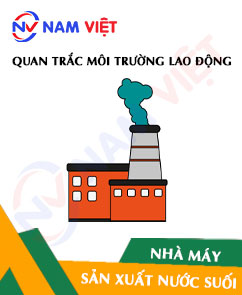
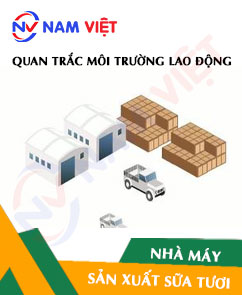
Review Occupational environment monitoring at the factory producing frozen meat
There are no reviews yet.